
Home sellers and agents need to decide on a pricing philosophy.
Do you price it high, and hope for the best? Or do you price it attractively and sell it promptly?
During the frenzy, pricing high was recommended because you couldn’t go wrong – everything was selling, and the worst case was settling for list price. Most sold over. But it’s different now, and you don’t want to be sloppy about price.
If a house doesn’t sell in the first month on the market, the buyers think the price is wrong, and will lowball – and you can’t blame them (wouldn’t you do the same?). The longer on the market, the worse it gets.
Let’s discuss it openly, for everyone’s sake.
If the list price is within 5% of being right, the house will sell in the first 30 days on the market. There is 5% of slush in every market, and there aren’t enough other sales nearby to say otherwise.
Let’s work it backwards. If the house doesn’t sell in the first 30 days, we know the price is at least 5% wrong. Because buyers are going to be conservative, they will want an additional 5% discount to feel secure.
After 30 days on the market, expect a 10% discount.
Sellers can object and try to fight it, but it will take luck to beat the odds – because the quality buyers are paying attention now, and without rising prices forcing them to make hasty decisions, they would rather wait, than to jump – especially when no one else has bit in the first 30 days.
After 30 days on the market, expect a 10% discount.
If it were a widely-publicized fact that pricing attractively avoids future peril, and if we all agreed that the 30+ day penalty was identified as -10%, then sellers could properly calibrate their expectations.
After 30 days on the market, expect a 10% discount.
If you want proof, here is my last graph that charted the NSDCC November sales:

If everyone – buyers, sellers, and agents – knew a discount was necessary after 30 days, the market would behave in a much more orderly and predictable way!




Filene’s basement:
The policy, put in place in 1908 by Edward A. Filene, the son of the founder of Filene’s, offered a 25 percent markdown on items not sold after two weeks and ratcheted that discount up to 50 percent after three weeks and 75 percent after four weeks. After five weeks, the item was given to charity.
—–
I still have and wear shoes I bought there in 1978-79 @75% off. Such high quality I’ve worn out two soles since.